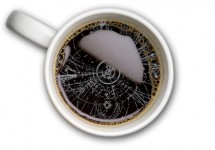Talks I have presented
I put this page together to provide access to the conceptual graphics that I've used in presentations. Unfortunately for you, I don't always explain what you're looking at on the slide because its purpose is to have something to point at while I'm speaking. Too many words would get in the way. If you want to use some graphics but need to understand the source or what it means, please e-mail me.
Some of these talks are general enough for any audience, while others are intended for professional physicists. They're all what I would consider major talks, whether for outreach or for conferences. (My complete list of talks averages one per week over a period of five years.) I also can't include any “internal” talks, presented within a scientific collaboration, since their content is considered provisional. Most of them wouldn't be interesting to many people, anyway.
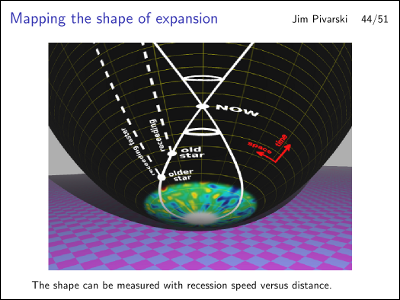
Date: March 4, 2012
Audience: the general public
This talk has a lot of conceptual graphics that would be good for other talks, blogs, etc. I might use some of them in a future Coffeeshop Physics post.
The dark matter section is pretty standard, except that I go through the whole argument about how alternatives to the current WIMP idea were ruled out (or mostly ruled out).
The dark energy section is really an extension of my
Stitch in Time (pants) article.

Date: December 8, 2011
Venue: CMU Undergraduate Colloquium
Audience: junior and senior physics majors
Physics undergrads are an interesting audience: they know enough to learn the technical details of a cutting-edge physics topic, but they usually don't know anything about the topic itself. This talk provides a semi-technical introduction to quantum field theory and the Higgs mechanism (both are grad school topics).

Date: October 10, 2011
Audience: drunken nerds
I gave a talk based on the
pants article at Villains Bar & Grill. It was late at night and the audience was getting drowsy, so I demonstrated gravity by jumping around a lot. The talk had a few new graphics, like the one shown here.

Date: June 1, 2011
Audience: professional particle physicists
A signature-based overview of the first year of CMS (LHC) exotica results. ("Exotica" is how physicists describe the “none of the above” category of searches. Some, but not all of this is out of date: see the
CMS public results page for updates.)

Date: October 29, 2010
Audience: professional particle physicists
A review of the first year of CMS results. The “Rediscovering the Standard Model” slide was very popular; a lot of physicists used it elsewhere.
Everyone in the audience was a physicist working on the LHC experiments. After all the hard work, I wanted to encourage them to take a look back and see where we were: naysayers predicted that it would take years to get from first beams to well-calibrated results, but even the complex techniques were well executed. That's why the talk has as much historical context as it does: to remind us what we were hearing and thinking just one year earlier.

Date: July 14, 2010
Audience: high-school students
One of my first outreach talks: two groups of high school students were visiting Fermilab— one American, the other Japanese. (That's why the Standard Model table is in Japanese, just for fun.)
It uses a chess-set metaphor throughout. I should use that metaphor again.
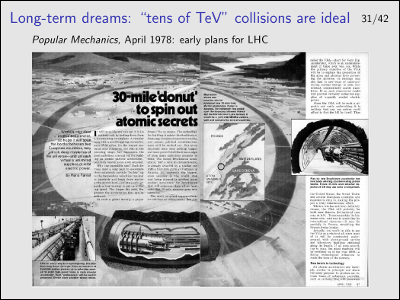
Date: February 25, 2010
Venue: Bard College Colloquium
Audience: undergraduates in any major
A historical motivation for the present-day search for the Higgs boson.
Slides about the theoretical developments and experimental results alternate, so the theory slides are yellow and the experimental slides are grey.

Date: July 30, 2009
Audience: professional particle physicists
My main work on CMS (one of the LHC experiments) was on the alignment of detectors designed to identify muons. This summarizes that work to physicists in other fields.
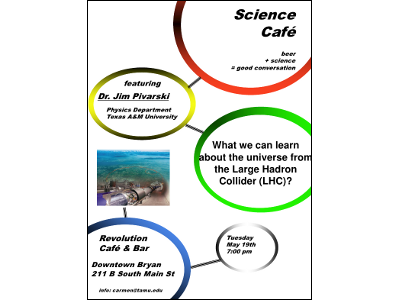
Date: May 19, 2009
Audience: the general public
This was a casual talk in a bar in Bryan, Texas. The LHC was all over the news at this point, so I wanted to put it into context: to get away from the “end of the world” stuff and explain why scientists want to do the experiment in the first place. To keep it informal, I wasn't allowed to use any presentation materials (slides), so I talked with my hands. From the pictures, I seem to be picking up individual protons and tossing them around. The “slides” stored here are the lecture notes and photos.

Date: January 6, 2009
Audience: professional particle physicists
I wanted to learn more about dark matter, so I attended a workshop on the connections between dark matter and the LHC. This talk is an overview of what the first year of CMS data-taking would be like, because it hadn't happened yet. The data plots are all simulations.
At this conference, I learned about the theoretical possibility of leptonic jets, which I searched for when the data became available. We didn't find any.

Date: June 26, 2007
Audience: experts in detector alignment
This one is very technical. The slide on the right shows an early stage of the detector (MTCC): only the chambers colored red had been installed at the time the data were taken (cosmic rays).
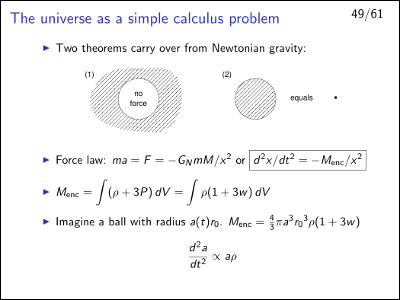
Date: May 10, 2007
Venue: Riemannian geometry study group
Audience: four math and physics postdocs and student
At Texas A&M, a group of four of postdocs and one graduate student arranged an informal class to teach ourselves about Riemannian geometry (curvature of surfaces and curvature of spaces). When I was at Cornell, we used to do informal classes a lot. I didn't contribute much to teaching that semester, so I made up for slacking with a single big lecture on spatial curvature in physics (real life).
This shows the mathematics behind the “universe as a shape” pictures I made in my March 2012 general-audience talk, as well as some primative early visualizations.
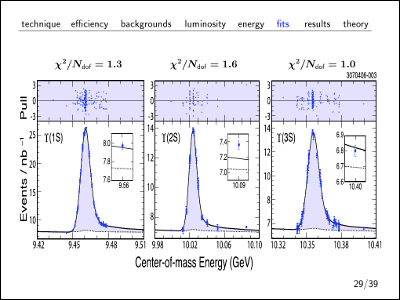
Date: March 26, 2006
Audience: professional particle physicists
Just a couple of months after my Ph.D., a fellow collaborator on the CLEO experiment asked me to give a talk at CMU (where I was an undergraduate, coincidentally). This is almost entirely about my thesis, though I put it in a wider context.
Venue: Seminar for grad students by grad students
Audience: math grad students
When I was a physics grad student at Cornell, I sometimes attended the math grad students' seminars, and on a few occasions, gave a talk. They were chalkboard talks, so no slides. I still have some notes, though...
- November 29, 2005: Why Stuff is Hard. Quantum field theory describes matter as diffuse clouds of probability— why, then, are rocks and hard things tangible? This is a question that bothered me, so I did some research and found a semi-satisfying answer. Some of this work appears in the December 2011 CMU colloquium and two Everything Seminar blog posts: Why Stuff is Hard and Why Everything is Hard.
- March 30, 2004: Bell's inequality: the spookiest thing about quantum mechanics. A mixture of chalkboard, transparencies, and some props to help convey the geometry of the experiment.
- October 21, 2003: Approximating everything. Big bang cosmology as a simple calculus problem. (Get it, “everything?”)
Date: August 2007 through September 2010
Audience: mathematicians who might be interested in physics
I was actually just a guest-blogger, and the blog was originally intended for cute math problems to interest research-level mathematicians. But it's a lot of work to produce articles like that, and the seminar-style posts gradually tapered off. Meanwhile, the LHC was starting up, and I filled the void with my news reports of how things were going.
These posts are in reverse order: latest to earliest.
- Coffeeshop Physics: announcement of this new blog
- My last LHC status update: a careful explanation of a new phenomenon discovered by CMS
- 7 TeV collisions tonight...: pointers to other blogs and insider news sources
- Particle body-count 2: well-known particles, “rediscovered” by the LHC; just knockin' em off, one by one
- The particle body-count: an earlier set, fewer particles; also a detailed explanation of what it means to see one of these particles
- Erratum: no high-energy collisions yet
- Rediscovering the Standard Model: “Particle body-count zero”
- Protons have collided in the LHC: equivalent of “The Eagle has landed”
- Protons have orbited the LHC!: play-by-play...
- "Beam-splashes" to arrive at CMS soon, possibly this weekend
- The Beam is Back: after a year of disrepair, the beam is once again functional (this is May 2009)
- What killed Madame Curie? (Part 4): my detective novel, which has undergone a lot of revisions since this early draft
- What killed Madame Curie? (Part 3)
- What killed Madame Curie? (Part 2)
- What killed Madame Curie? (Part 1): I didn't tell anyone that I was going to do this; I wanted to see what people would do if fiction just started appearing on the blog
- The new LHC schedule
- Pictures from the LHC incident: ouch (but it's been fixed now)
- CERN releases report on LHC incident
- "Live" video of LHC particles: I made this animation of beam-halo muons passing through CMS from the real data we got in 2008 before the Incident; includes a picture of the French Prime Minister watching it!
- This is not sensitive information!: some physics bloggers took my earlier posts as evidence that CERN was hiding the extent of the LHC damage (that I was an insider leaking the truth). It bugged me. What I was saying wasn't different in substance from the CERN reports (in fact, I was largely relying on the CERN reports; I ignored the rumors). I did use different terms, though— instead of phrases like “rapid release of pressure in which large forces were involved” I used the E-word, “explosion.” That was my introduction to the perils of P.R.
- No LHC beams until next year: reading this post now, it sounds a lot less depressed than I remember being when I wrote it
- Two-month delay for the LHC: my first post on the Incident; in retrospect, it's technically accurate except for the time estimate on the delay
- Made in the U.S.A.: a silly half-paragraph about the Newsweek cover, since they were trying to make the point that the biggest thing in science is European, and they did so by showing a subdetector largely built by U.S. universities
- The LHC is clear!: the 2008 beam got all the way around the ring
- Beautiful beam-halo tracks in CMS!: pictures of the first few minutes of data, with Big Bird for scale
- LHC beam through CMS
- Details for LHC First Beam Day: hyperlinks to official sources
- LHC beam particles observed by a detector: LHCb, the experiment closest to the entry point for the beam
- First data from GLAST: completely unrelated to the LHC, but I like astrophysics (GLAST is now known as the Fermi Space Telescope)
- Yet further around the LHC: the correct word is “farther,” Jim...
- Pictures from the Control Room: if you've ever wondered what a modern particle physics control room looks like, take a look
- More updates from the LHC and CMS: a terminal display showing the beamspot (almost in the middle of the pipe, but not quite)
- Physics and cateogry theory: half-paragraph about something I read on the arXiv
- On third thought...: nice beamspot pictures with a diagram of the instrument that takes the pictures
- LHC press release: first circulating beam on September 10: this was August 8; short description of the beam-halo we were expecting to see
- LHC Updates: Watch this Space: my first LHC blog post
- Quantum Bears: interaction between quantum mechanics and classical chaos
- Why Everything is Hard: see Olivetti Talks above
- Why Stuff is Hard: also see Olivetti
- The Origin of Mass?: overview of Higgs physics; the sort of post that might appear on Coffeeshop Physics, except that it's a bit hard to understand (spastically written).
